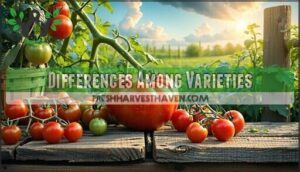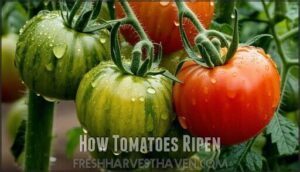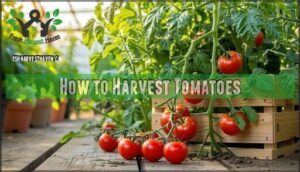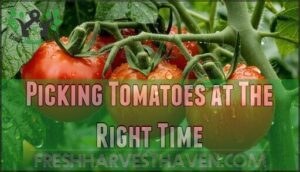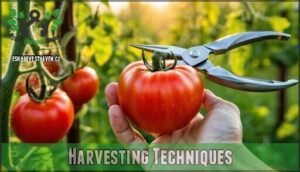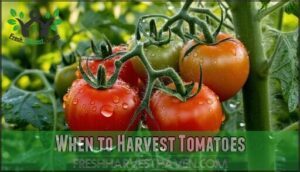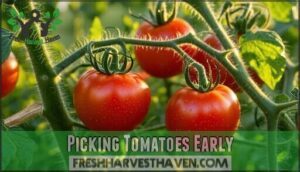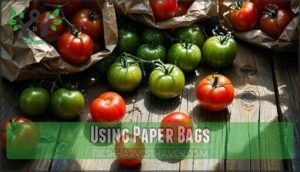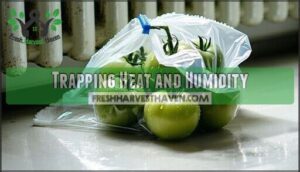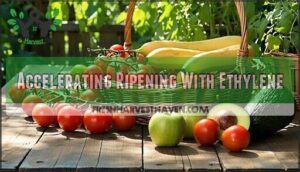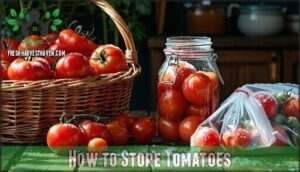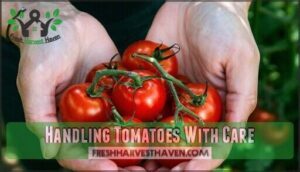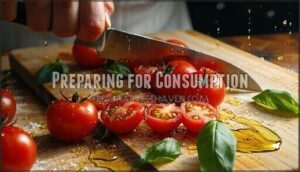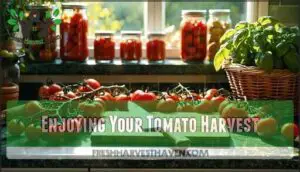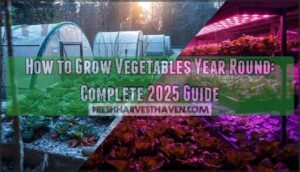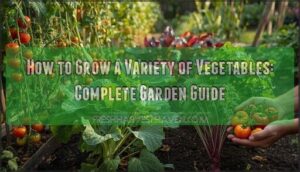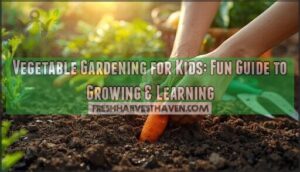This site is supported by our readers. We may earn a commission, at no cost to you, if you purchase through links.
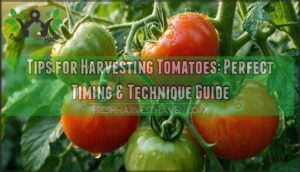
Pick them in the morning when it’s cool, and twist gently while pulling upward to avoid damaging the vine.
Don’t wait until they’re completely soft—tomatoes continue ripening after harvest.
For cherry varieties, harvest when they’re fully colored but still firm.
Larger tomatoes can be picked when they show a hint of color and will finish ripening indoors.
The secret lies in understanding each variety’s unique ripening signals and timing your harvest perfectly, which involves recognizing the mature shade.
Table Of Contents
- Differences Among Varieties
- How Tomatoes Ripen
- How to Harvest Tomatoes
- When to Harvest Tomatoes
- Picking Tomatoes Early
- How to Ripen Tomatoes Indoors
- How to Store Tomatoes
- Handling Tomatoes With Care
- Preparing for Consumption
- Enjoying Your Tomato Harvest
- Frequently Asked Questions (FAQs)
- How do you harvest a tomato?
- Should I Harvest my tomatoes before they are ripe?
- How often should you harvest Tomatoes?
- What should I do after harvesting tomatoes?
- How do you know when a tomato is ready to harvest?
- When is the right time to harvest tomatoes?
- Should you cut or pull tomatoes off the vine?
- How can I improve my tomato harvest?
- How do you get the highest yield on tomatoes?
- Should I pick tomatoes when they are green?
- Conclusion
Differences Among Varieties
Not all tomatoes ripen the same way, so you’ll need to adjust your harvesting approach based on what you’re growing.
Cherry tomatoes need to reach 90% color before picking, while beefsteak varieties can be harvested at the pink stage and will continue ripening off the vine.
Heirloom Tomatoes
The allure of heirloom tomatoes stems from their remarkable diversity and unmatched taste experiences.
These treasured varieties carry Historical Significance that connects you directly to generations of passionate gardeners who’ve preserved their seeds through decades of careful cultivation.
Heirloom tomatoes are living history—each bite connects you to generations of gardeners and their unmatched, vibrant flavors.
Perfectly timed harvests turn your garden’s treasure into kitchen gold—every tomato tells the story of your growing mastery.
When you’re mastering tomato harvesting with heirloom varieties, you’ll notice they require different attention than standard types.
Look for ripe tomato signs like subtle color changes and gentle softening, but harvest before full ripeness to prevent splitting from their thin, delicate skins.
To avoid issues like cracking and sunscald, consider early harvesting techniques.
Each heirloom variety offers distinct advantages:
- Heirloom Flavor Profiles: Complex tastes ranging from sweet to smoky, fruity to earthy
- Unique Coloration: Stunning purples, greens, yellows, and striped patterns that captivate
- Disease Resistance: Natural adaptation to local growing conditions over generations
- Culinary Diversity: Perfect for fresh eating, specialty sauces, and gourmet presentations.
Understanding these tomato harvesting tips guarantees you’ll capture their peak flavor and preserve their delicate integrity.
Cherry Tomatoes
Cherry tomatoes pack intense sweetness factors when you harvest them correctly.
Wait until they show 90% color development with no green shoulders—vine ripening delivers the best flavor since they won’t improve much after picking.
Check your plants daily for cracking prevention during hot weather, as these delicate gems split easily.
Variety selection matters for culinary uses, from salads to garnishes.
Following proper tomato harvesting tips guarantees you’ll catch ripe tomato signs at their peak sweetness.
Roma/Sauce Tomatoes
Roma tomatoes are the workhorses of sauce tomato texture, delivering thick, meaty flesh with minimal seeds.
You’ll want to master harvesting tomatoes at peak Roma tomato flavor – wait until they’re completely red before picking.
Their determinate ripening means your entire crop will mature within a concentrated timeframe, perfect for canning Roma tomatoes in bulk batches.
Use the tomato firmness test – ripe Romas yield slightly to pressure.
These Roma tomato recipes champions excel in sauces, paste, and preserving projects.
Beefsteak/Red Slicing/Hybrid Tomatoes
While Roma tomatoes excel in sauces, beefsteak tomatoes reign supreme for fresh eating and slicing techniques. These heavyweight champions showcase impressive hybrid vigor, producing fruits weighing 8-32 ounces that demand your attention during harvesting tomatoes season.
Your tomato ripeness guide should focus on the turning or pink stage—when 50% of the fruit shows color. This timing delivers ideal beefsteak flavor and prevents these giants from becoming overripe on the vine. The tomato firmness test works perfectly here: gently squeeze and feel for slight give while maintaining structural integrity.
Red varieties like these need proper growth support since their size can snap branches.
Here’s your picking ripe tomatoes checklist:
- Check for vibrant red coloration starting from the bottom
- Harvest when slightly soft but still firm
- Support plants with sturdy cages or stakes
- Avoid overcrowding fruit on vines
- Inspect daily during peak ripening season
How Tomatoes Ripen
You’ll understand your tomatoes better when you know how they ripen through distinct stages, from mature green to fully red.
Your tomatoes produce ethylene gas during the breaker stage, which triggers color changes and flavor development, allowing you to harvest early and ripen them off the vine.
Ripening Stages
Understanding tomato ripeness means recognizing the five distinct ripening stages that transform your green fruits into flavorful treasures.
It starts with Mature Green, when tomatoes reach full size but show no color change. Next comes the Breaker Stage—you’ll spot a tiny blush of pink or yellow breaking through the green skin. Turning Pink follows, with about 30% color development spreading across the fruit. Light Red appears when roughly 60-90% shows color, and tomato firmness begins to soften slightly. Finally, Ripe Red delivers full tomato color with perfect tomato texture—firm yet yielding to gentle pressure.
Each ripening stage offers different harvest opportunities.
You can pick tomatoes at any stage after Breaker and let them finish ripening indoors, giving you control over timing and preventing weather damage.
Ethylene Release
Once your tomato reaches the breaker stage, it becomes an ethylene production powerhouse.
This natural gas triggers ripening acceleration from the inside out, transforming your green fruit into a flavorful masterpiece.
The tomato ripening process relies heavily on this ethylene release, which you can’t see but definitely benefits from.
Here’s how ethylene sources affect your harvest:
- Warmer temperatures boost ethylene production and speed up ripening
- Nearby ripe fruits release additional ethylene, creating a ripening chain reaction
- Controlled ripening becomes possible using ethylene inhibitors or proper storage
- Temperature effects can either accelerate or slow the entire process
Understanding tomato ethylene helps you time your harvest perfectly.
Optimal Ripeness
Your tomato’s ethylene production signals it’s time to master optimal ripeness detection. Perfect ripeness indicators include full color development and gentle yielding when squeezed—not mushy, just slightly soft. Peak flavor occurs when tomato maturity reaches its sweet spot, typically showing complete varietal coloring.
Harvesting windows vary by variety, but ethylene influence guarantees continued ripening even after picking, giving you flexibility in tomato harvesting timing.
How to Harvest Tomatoes
Harvesting tomatoes correctly guarantees you’ll get the best flavor and extend your plant’s growing season.
You’ll need to know when they’re ready, use the right technique to pick them, and handle them properly to avoid damage, which will help you get the best results from your harvest.
Pre-Harvest Preparation
Getting your gear ready for harvest makes all the difference between bruised fruit and perfect tomatoes.
Your preharvest preparation sets the stage for successful tomato harvesting tips that’ll make your neighbors jealous.
Start by assembling your harvest toolkit:
- Sharp, clean pruning shears to make precise cuts without damaging your tomato plant care investment
- Shallow baskets lined with soft towels to cradle your precious cargo and prevent bruising
- Quality garden gloves to protect hands from plant acids and rough support structures
Check your soil preparation moisture levels before heading out—dry conditions mean cleaner fruit and less disease risk.
Review the weather forecast too, since harvesting before rain prevents splitting.
Using the correct tools, like specialized tomato shears, can improve your harvest.
Your variety selection determines timing, but proper prep guarantees you’ll capture peak tomato maturity regardless of type.
Picking Tomatoes at The Right Time
Perfect harvest timing separates good gardeners from great ones. Don’t wait for complete redness – that’s actually too late for most varieties.
Look for the first blush of color at the bottom, signaling the key breaker stage. This optimal stage occurs when tomatoes show about 50% color development.
Ripeness indicators vary by type: cherry tomatoes need 90% color, while beefsteak varieties shine at the turning stage.
Weather impact matters too – harvest before heavy rain to prevent splitting. Daily checks during peak season help you catch that perfect when to pick tomatoes moment for maximum flavor.
Harvesting Techniques
Once you’ve nailed harvest timing, mastering proper tomato harvesting techniques becomes your next priority. Start with tool selection – clean, sharp scissors or pruning shears work best for cutting stems about half an inch above the fruit. This prevents plant damage and maintains healthy growth.
Your gentle handling approach makes all the difference. Grasp each tomato near the stem, supporting its weight from below while cutting. Avoid the tempting twist-and-pull method that damages both fruit and vine.
Weather impact plays a huge role in successful tomato picking. Always harvest during dry conditions to prevent disease spread between plants. For ideal flavor, consider assessing tomato ripeness using a combination of color, texture, and aroma.
- Variety-specific harvesting requires different approaches – cherry tomatoes need frequent daily checks, while beefsteak varieties benefit from earlier picking at the pink stage.
Remember, how to harvest tomatoes properly protects your investment and maximizes your garden’s potential yield.
Post-Harvest Handling
Once you’ve mastered the picking technique, smart post-harvest handling keeps your tomatoes in peak condition.
Place harvested tomatoes stem-side down in shallow containers for bruising prevention and better shelf life. Don’t stack them—overcrowding damages delicate skin.
Remove any damaged fruit immediately to prevent spoilage from spreading. Proper storing harvested tomatoes starts with gentle placement and temperature control for ideal tomato storage.
Action Why It Works Best Practice
Temperature impact on postharvest shelf life can’t be overstated!
When to Harvest Tomatoes
You don’t need to wait for tomatoes to turn completely red on the vine, since they’ll ripen perfectly after you pick them at the "breaker stage" when they show their first blush of color.
Knowing the right time to harvest means you’ll get better flavor, avoid cracking from rain, and keep your plants producing more fruit throughout the season, which is a key factor in maintaining healthy plants.
Color Change
Beyond harvest techniques, color development serves as your most reliable visual cue for determining tomato ripeness.
Pigment changes occur in predictable ripening stages, making color your go-to indicator for perfect timing.
Watch for these varietal colors when evaluating readiness:
- Red tomatoes – Deep, uniform red with no green shoulders or streaks
- Yellow/orange varieties – Consistent golden tones throughout the entire fruit
- Purple/black tomatoes – Rich, deep pigmentation without dull patches
- Green varieties – Yellowish blush appears when fully mature
Check your tomatoes daily—these visual cues change rapidly during peak season!
Firmness and Squeeze Test
Your fingertips become the ultimate ripeness detector when harvesting tomatoes.
Your fingertips hold the secret to perfect harvest timing—gentle pressure reveals when tomatoes are ready to shine.
Apply gentle pressure to assess firmness—a ripe tomato yields slightly to touch while maintaining structure. Softness indicators vary by variety, so compare firmness across your plants.
The squeeze test reveals perfect timing: too firm means wait longer, while excessive yielding to touch signals overripeness approaching.
Ripeness Level
Different varieties require varying handling pressure, so adjust your touch accordingly for ideal firmness assessment.
Avoid Overripe Tomatoes
Once you’ve tested firmness, watch for telltale signs that signal you’ve waited too long. Identifying overripeness saves your harvest from disappointment and keeps your plants productive.
Here’s how to spot tomatoes past their prime:
- Wrinkled skin with soft, dark patches appearing
- Mushy texture that collapses under gentle pressure
- Fermented flavor replacing the sweet-tangy taste
- Spontaneous juice leakage when handling the fruit
Preventing overripening means harvesting tomatoes at the pink or light red stage. This approach delivers better tomato flavor and extends storage time. Overripe tomato uses include sauces or compost, but fresh eating becomes impossible once they’ve crossed that line.
Extreme Temperature Harvesting
When extreme temperatures threaten your tomato patch, timing becomes everything.
During heatwave harvesting, pick fruits at the first color change and install shade cloth for sunscald prevention.
You’ll preserve flavor while avoiding heat damage.
Cold snaps require immediate frost protection—cover plants with blankets or harvest mature green tomatoes.
Cold climate gardeners benefit from early picking since tomatoes ripen beautifully indoors at ideal timing.
Don’t let weather extremes rob you of your harvest’s full potential with improper timing, as early picking can be crucial.
Picking Tomatoes Early
You don’t have to wait for tomatoes to turn completely red on the vine to enjoy perfect flavor and texture.
Picking tomatoes at the breaker stage (50% color showing) lets you control ripening while preventing splitting, pest damage, and weather-related problems, which is crucial for achieving perfect flavor.
Benefits of Early Harvest
Many gardeners wonder if picking tomatoes before they’re fully red actually helps their harvest. The answer is absolutely yes, and early harvesting offers several compelling advantages that can transform your growing season.
When you harvest tomatoes at the breaker stage, you’re setting yourself up for success in multiple ways:
- Reduced splitting from weather extremes and overwatering damage
- Pest avoidance since animals prefer fully ripe fruit over green tomatoes
- Extended shelf-life through controlled ripening indoors at your pace
- Marketable produce with consistent quality and appearance standards
Green tomatoes ripen perfectly off the vine, maintaining their flavor while your plants focus energy on producing new fruit. This early harvesting strategy maximizes your tomato harvesting potential throughout different ripening stages.
Storage and Ripening
Your early harvest transforms into garden gold with proper storage and ripening techniques. Green tomatoes ripen beautifully indoors when you control their environment.
Here’s how different tomato varieties progress through ripening stages:
- Store stem-side down at room temperature for ideal Ethylene Control
- Maintain Ripening Temperatures between 65-70°F for Flavor Preservation
- Use Storage Methods like paper bags to trap natural ethylene gas
- Check daily for Extending Shelf-Life while monitoring tomato harvesting progress
Room temperature beats refrigeration every time. Consider pairing your harvest with seasonal spring side dishes for a balanced meal.
Preserving Tomatoes
With a bounty of early-picked tomatoes, you’ll want to transform them into lasting treasures.
Freezing tomatoes works beautifully—just pop whole ones into bags for future tomato sauces. Canning methods create shelf-stable jars lasting over a year, perfect for winter soups. Drying techniques concentrate flavors into chewy, sweet chips that pack incredible punch.
Try making pickled tomatoes for tangy side dishes, or blend them into rich tomato sauce for pasta nights.
Tomato preservation doesn’t have to be complicated—even simple tomato freezing beats letting them rot on the counter.
Each preservation method reveals different flavors and textures. With these tomato recipes in your toolkit, you’ll savor summer’s harvest all year long!
How to Ripen Tomatoes Indoors
You can turn your kitchen counter into a ripening station for green tomatoes that didn’t have time to finish on the vine.
Simple techniques like paper bags and room temperature storage will help you enjoy perfectly ripe tomatoes even after the growing season ends.
Using Paper Bags
Paper bags create the perfect mini greenhouse for indoor ripening. Simply place your green tomatoes inside with a ripe banana or apple—these fruits boost ethylene gas production naturally.
The bag material allows proper humidity control while preventing mold prevention issues that plastic causes. Keep bags at room temperature and check daily for progress.
This method increases ethylene concentration around your tomatoes, dramatically improving ripening speed compared to countertop storage alone.
Trapping Heat and Humidity
Creating the perfect microclimate for bag ripening transforms your green tomatoes into ripe treasures.
You’ll need to master humidity control while maintaining warm conditions that mimic a natural greenhouse. The sweet spot lies between controlled moisture and proper airflow.
Here’s how to optimize heat and humidity for faster ripening:
- Maintain humidity levels between 85-90% using slightly damp paper towels
- Position bags near gentle heat sources like radiators or warm countertops
- Guarantee mold prevention by checking for excess moisture daily
- Create perfect ethylene concentration by keeping bags loosely closed
- Monitor condensation risks by opening bags briefly each morning
The humidity impact accelerates color development, but balance is key. Too much moisture invites trouble, while too little slows the process. Your tomatoes will ripen beautifully when you nail this delicate dance.
Accelerating Ripening With Ethylene
Beyond paper bags, you can supercharge your tomato ripening with smart ethylene sources. Toss a ripe banana or apple into your setup—these fruits pump out natural ethylene gas, accelerating ripening by days.
Temperature effects play a huge role too; warmer spots boost the process while cool areas slow it down.
| Ethylene Source | Ripening Speed | Best Use |
|---|---|---|
| Banana | 2-3 days faster | Small batches |
| Apple | 1-2 days faster | Large quantities |
| Avocado | 1-2 days faster | Gentle ripening |
| No fruit added | Standard pace | Ripening control |
How to Store Tomatoes
You’ve successfully harvested your tomatoes, but proper storage makes the difference between enjoying them for days or watching them turn to mush on your counter.
Your storage method depends on ripeness level and how quickly you plan to use them, with options ranging from room temperature ripening to long-term preservation through freezing and canning.
Room Temperature Storage
Room temperature storage keeps your tomatoes at their flavor peak. Place them stem-side down on your counter, away from direct sunlight exposure that causes uneven ripening.
Ideal temperature ranges from 65-70°F with proper air circulation around each fruit. Optimal containers include shallow bowls or baskets that prevent crowding.
Maintain moderate humidity levels by avoiding paper bag storage, which traps moisture. Keep tomatoes separated from ethylene sources like bananas unless you want faster ripening.
This room temperature method beats refrigeration avoidance for preserving that garden-fresh taste.
Refrigeration and Freezing
When room temperature isn’t enough, refrigeration and freezing extend your tomato harvest substantially.
Refrigeration effects include slower ripening and firmer texture, though flavor preservation can diminish below 50°F.
For freezing methods, select ripe, firm tomatoes and wash thoroughly before packaging.
- Whole tomato freezing: Simply pop them in freezer bags – the skins slip off easily after thawing tomatoes
- Chopped storage: Cut into pieces, leaving 1-inch headspace in containers to prevent bursting
- Quality timeline: Frozen tomatoes maintain best tomato quality for 6 months with proper tomato storage
Consider using specialized bags for safe freezing to maintain quality.
Remember, texture changes occur during freezing, so use thawed tomatoes only in cooked dishes where their softer consistency won’t matter.
Canning and Drying
While freezing gives you quick access to tomatoes, canning and drying techniques transform your harvest into pantry gold.
Water bath canning works perfectly for high-acid varieties—just follow USDA-tested recipes for storage safety. For drying techniques, slice Roma or San Marzano tomatoes evenly and use dehydrators or sun-drying methods.
These canning methods preserve intense flavors while recipe adaptation becomes easier with concentrated tomato powder. Remember that proper harvesting tomatoes at peak ripeness guarantees better flavor retention in your preserved goods, whether you’re making sauce or creating sun-dried Mediterranean delicacies.
For safe canning practices, always add lemon juice for acidity to your tomato products.
Method Best Varieties Preparation Tips Shelf Life
For ideal results with sun-dried tomatoes, fill jars only halfway with dried fruit and add juice to fill—they’ll absorb the liquid and swell.
High-acid varieties like San Marzano work wonderfully for drying, while low-acid tomatoes turn black when dehydrated.
Remember to peel tomatoes before preserving for the best texture and taste in your sauces and Mediterranean dishes.
Shelf Life and Storage Tips
After mastering canning and drying techniques, you’ll want to maximize your post harvest tomato shelf life through smart storage choices.
Your storage approach depends on ripeness and timing. Here’s how to keep tomatoes fresh longer:
- Room Temperature Storage – Keep ripe tomatoes on your counter for 5-7 days, away from direct sunlight
- Refrigeration Guidelines – Store overripe tomatoes in the fridge to slow deterioration, though flavor diminishes slightly
- Freezing Tomatoes – Freeze whole tomatoes for 6-8 months; they’re perfect for cooking after thawing
- Ethylene Gas Management – Place green tomatoes in paper bags to trap natural ripening hormones
- Humidity Control – Use breathable containers to prevent moisture buildup that causes spoilage
Handle tomatoes gently during storage since bruising accelerates decay. Never stack them high, and check regularly for soft spots that signal it’s time to use them up.
Handling Tomatoes With Care
You’ll want to treat your tomatoes like precious gems when harvesting, since bruised or damaged fruit spoils quickly and attracts pests.
Handle each tomato gently with clean hands or tools, avoiding pressure that creates soft spots or tears in the delicate skin, to prevent them from spoiling and attracting pests.
Avoiding Damage
Damage-free tomato harvesting starts with smart choices that protect your precious crop.
Clean, sharp tools prevent disease spread while gentle handling keeps fruit intact.
Weather protection shields ripening tomatoes from rain-induced splitting, and pest prevention stops critters from damaging your harvest.
| Damage Type | Prevention Method | Tool/Technique |
|---|---|---|
| Bruising | Gentle handling techniques | Soft-lined containers |
| Splitting | Weather protection covers | Row covers, shade cloth |
| Disease | Clean tool selection | Sanitized pruners, scissors |
| Pest damage | Pest prevention barriers | Netting, companion planting |
| Stacking damage | Stacking avoidance practices | Shallow harvest baskets |
Never stack tomatoes—this crushes lower fruit and shortens shelf life substantially, which is why gentle handling and clean tool selection are crucial for a successful harvest, emphasizing the importance of damage-free practices.
Gentle Harvesting
Your hands can make or break a perfect tomato harvest. Gentle handling prevents unnecessary damage and keeps your fruit looking market-fresh. Think of each tomato as a delicate egg – it needs your careful attention.
- Use clean, sharp scissors or pruners for precise stem detachment without tearing
- Support the tomato’s weight in your palm while cutting to prevent dropping
- Twist gently rather than yanking to achieve clean harvesting and avoiding splits
- Handle one tomato at a time using proper harvesting techniques for bruising prevention
Careful handling during harvesting tomatoes with quality tomato harvesting tools guarantees your hard work pays off with beautiful, unblemished fruit. To maximize flavor, consider the breaker stage harvest for a longer shelf life.
Preventing Moisture and Disease
Beyond gentle handling, moisture control keeps your tomatoes healthy and disease-free.
Water at soil level using proper watering practices to avoid wet leaves that invite fungal diseases. Improve air circulation through smart pruning techniques around developing fruits.
Pick during dry afternoons when plants aren’t damp. Remove cracked fruits immediately—tomato cracking spreads problems fast.
Strong soil health builds natural disease resistance, making harvesting tomatoes easier. Smart disease prevention starts with controlling humidity around your plants.
Preparing for Consumption
Once you’ve harvested your perfect tomatoes, you’ll want to prepare them properly for the best eating experience.
A quick rinse under cool water removes any dirt or garden residue, and knowing the right cutting techniques helps you get the most flavor from each variety.
This step is crucial for bringing out the best flavor in your tomatoes.
Washing and Cleaning
Fresh-picked tomatoes need proper post-harvest preparation before they’re kitchen-ready. Start with a gentle rinse under cool water to remove garden debris and surface dirt—no soap required.
For sauce-making batches, a quick vinegar solution dip provides extra protection against contamination.
- Washing methods: Use flowing cool water rather than soaking to prevent bacterial absorption
- Cleaning solutions: Plain water works best; vinegar solution for canning prep only
- Drying techniques: Pat gently with clean towels or air-dry on racks
- Storage cleanliness: Make certain containers are sanitized before storing washed tomatoes
- Preventative measures: Inspect each tomato for cuts or blemishes during cleaning
Slicing and Chopping
Clean tomatoes are ready for the next step in your tomato prep journey. Sharp knife selection makes all the difference—dull blades crush cells and release unwanted moisture.
Master these essential cutting techniques:
- Slicing: Use serrated knife for clean, even rounds
- Dicing: Cut uniform cubes without bruising flesh
- Seed removal: Scoop out seeds for concentrated flavor
- Slice thickness: Match cuts to your fresh tomato recipes
Consistent cuts guarantee even cooking and maximum flavor impact.
Cooking and Recipes
Transform your harvest into delicious meals with these crowd-pleasing tomato recipes that’ll make you the neighborhood cooking hero:
- Rich Tomato Sauces – Create memorable pasta nights that bring families together around the dinner table
- Zesty Fresh Salsas – Watch guests rave about your garden-fresh dips at every gathering
- Colorful Tomato Salads – Feel satisfied serving vibrant dishes that showcase your growing skills
Don’t forget fried green tomatoes and canning recipes to preserve your bounty year-round.
Enjoying Your Tomato Harvest
Now that you’ve mastered the art of harvesting tomatoes at their peak, it’s time to turn those perfectly picked fruits into delicious meals and preserved treats.
Whether you’re slicing fresh heirlooms for a summer salad or turning Roma tomatoes into rich sauce, proper harvesting techniques guarantee you’ll get the best flavor and nutrition from every single tomato, which is essential for making delicious meals.
Fresh Tomato Recipes
Your perfectly ripened tomatoes shine brightest in fresh tomato recipes that highlight their natural sweetness.
Create vibrant tomato salad combinations with herbs and cheese, or blend cooling gazpacho variations for summer relief.
Top crusty bread with flavorful bruschetta toppings, mix cherry varieties into zesty salsa recipes, or thread caprese skewers for effortless entertaining.
Each bite celebrates your harvest’s exceptional tomato flavor profile and superior tomato quality.
Preserved Tomato Recipes
Your bumper crop doesn’t have to overwhelm you. Canned tomatoes preserve that peak-season flavor for months, while dried tomatoes concentrate sweetness into chewy gems. Fermented tomatoes add tangy complexity to winter dishes.
You can also explore various methods for safely canning tomatoes to extend their shelf life.
- Tomato sauces – freeze in portions for easy weeknight meals
- Tomato chutneys – blend sweet and savory for cheese boards
- Oil-packed confit – transforms ordinary tomato recipes into gourmet experiences
Tips for a Bountiful Harvest
Four essential tomato harvesting tips will maximize your tomato yield season after season:
- Feed soil consistently with quality compost to boost tomato quality and harvest frequency
- Monitor plants daily using proper harvesting tools for effective pest prevention
- Apply steady watering while considering weather considerations to prevent stress
- Practice post-harvest care by removing damaged foliage immediately
These tomato harvest best practices guarantee abundant tomato harvesting tips for years ahead!
Frequently Asked Questions (FAQs)
How do you harvest a tomato?
Unlike picking berries, harvesting tomatoes requires gentle precision.
Grasp the fruit firmly while supporting the stem, then twist until it snaps cleanly.
You can also use sharp scissors to cut just above the calyx for cleaner results.
Should I Harvest my tomatoes before they are ripe?
Yes, you should harvest tomatoes at the "breaker stage" when they’re 50% colored. They’ll ripen perfectly off the vine while avoiding splitting, sunscald, and pest damage that can ruin vine-ripened fruit.
How often should you harvest Tomatoes?
Peak tomato season requires daily harvesting to prevent overripening.
You’ll need to check your plants every 24-48 hours during summer months.
Regular picking encourages more fruit production and prevents splitting from rain or heat stress, which is crucial for a healthy harvest and can be considered a key part of regular maintenance.
What should I do after harvesting tomatoes?
After harvesting your tomatoes, handle them gently to prevent bruising.
Store ripe ones at room temperature for immediate use, or place green tomatoes in a paper bag to ripen naturally within days.
How do you know when a tomato is ready to harvest?
Look for color, feel for firmness, check for ripeness.
You’ll know your tomato’s ready when it shows its variety’s true color and yields slightly to gentle pressure, signaling peak flavor and perfect eating quality.
When is the right time to harvest tomatoes?
You’ll want to harvest tomatoes when they show their first blush of color.
That’s the "breaker stage" where they’re half green, half pink, and will ripen perfectly off the vine.
Should you cut or pull tomatoes off the vine?
You can either cut or pull tomatoes from the vine, but cutting with clean scissors prevents plant damage.
For small varieties like cherry tomatoes, gentle twisting works best.
Choose what feels comfortable.
How can I improve my tomato harvest?
Pick tomatoes when they show their true colors—literally.
Use sharp scissors, don’t yank, and check daily for ripeness.
Keep your harvest out of the rain, and remember, a gentle touch beats a wrestling match every time.
How do you get the highest yield on tomatoes?
Think of your tomato plants as a gold mine—feed them well, water deeply, and prune for airflow.
Harvest regularly, check daily for ripe fruit, and use sharp shears.
Healthy plants and quick picking mean bigger, better yields, which is the ultimate goal of cultivating your tomato plants with careful prune for maximum output.
Should I pick tomatoes when they are green?
You can harvest tomatoes when they’re green, especially if frost or critters threaten.
They’ll ripen off the vine thanks to ethylene gas.
Just keep them at room temperature, maybe in a paper bag with a banana for company.
Conclusion
Like waiting for toast to pop, patience pays off when you follow these tips for harvesting tomatoes.
Check color, give a gentle squeeze, and pick at the right time for the best flavor.
Remember, tomatoes keep ripening after harvest, so don’t stress if they’re not perfect.
Handle them gently, store them properly, and you’ll enjoy tasty tomatoes for weeks.
With a little practice, you’ll master the art of harvesting and enjoy every juicy bite.
- https://www.espoma.com/fruits-vegetables/harvesting-tomatoes-made-easy/
- https://joegardener.com/when-is-the-best-time-to-pick-a-tomato/
- https://www.gardenersbasics.com/tools/blog/when-to-pick-tomatoes-a-guide-to-harvesting-your-crop
- https://laidbackgardener.blog/2024/08/27/all-about-harvesting-tomatoes/
- https://thefarminginsider.com/tomato-harvesting-techniques/

